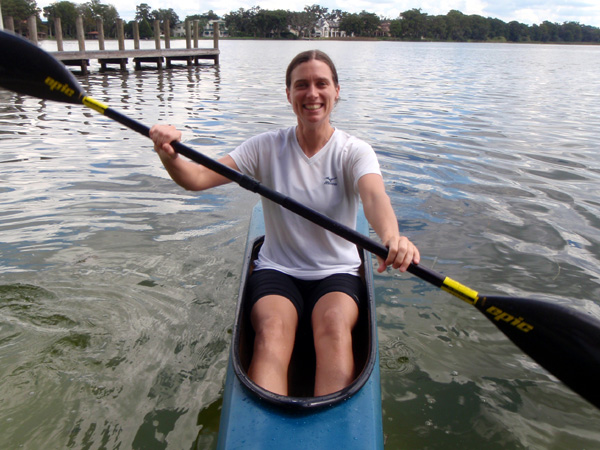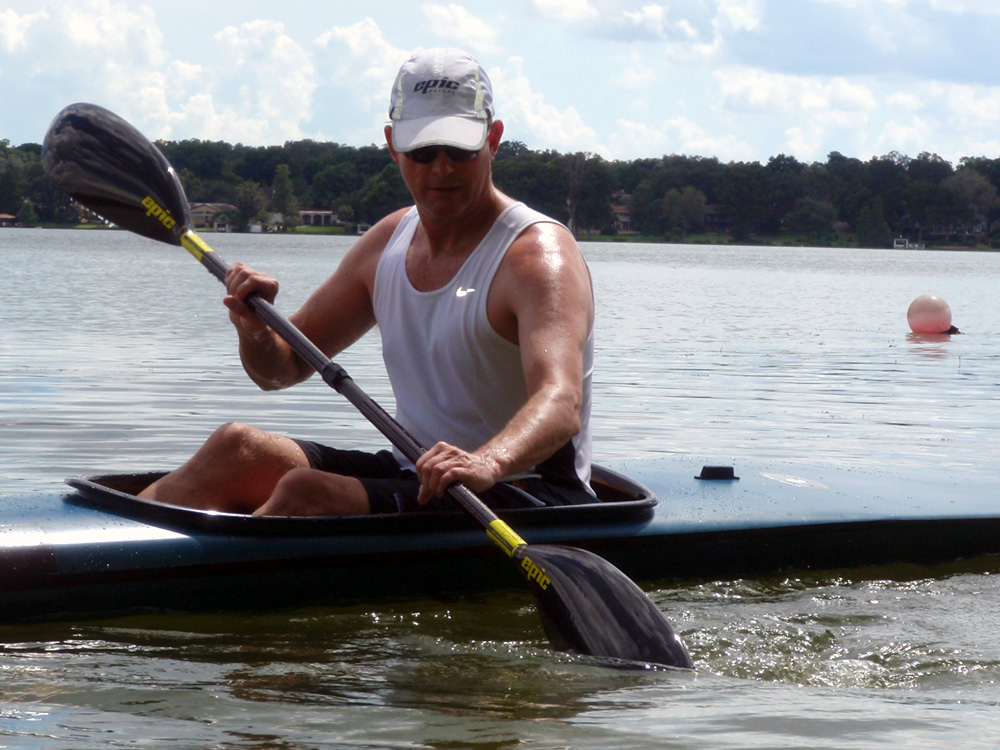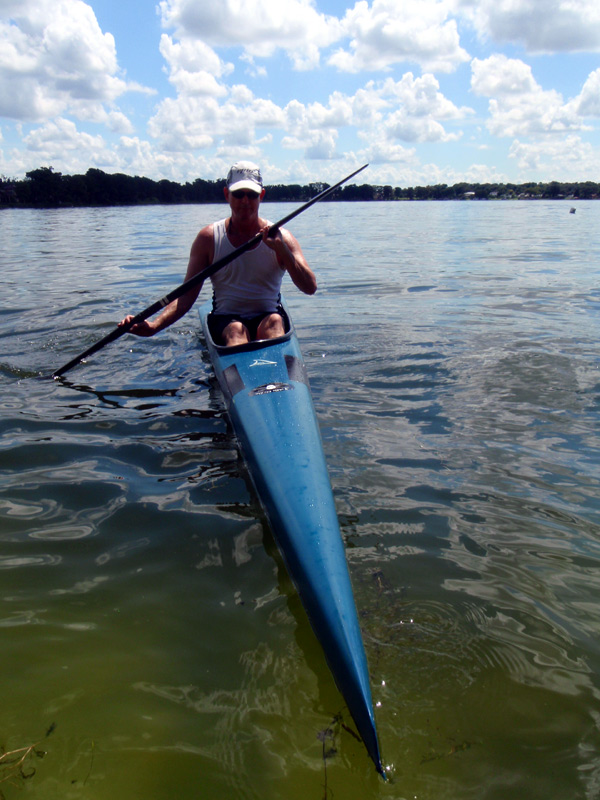K1 First Impressions…
Posted by Greg on January 11, 2012
I’m happy to report that my fragile male ego wasn’t bruised too badly, first time in a K1 🙂 At least I didn’t unintentionally swim but my bracing and sculling skills were heavily tested. My girlfriend, Pauline Besson, did very well, and managed to stay upright, but did have a capsize or two. Most other friends who tried it went about fifteen feet, the boat flopped to its side, and into the drink they went.
“You’ve got to be kidding me!”
For the first few minutes Pauline stabilized the K1 while I simply got accustomed to the feel. My first thought was, “You’ve got to be kidding me”! I was (over) confident that it would be a piece of cake, however the initial stability, or rather the lack of it, was much different to anything I have been in before, and that includes some very narrow V-hulled boats.
I knew the key was to relax, but my hip-flexors went into overdrive trying to balance. Nervous waves radiated quickly away from the kayak. “Stop IT!”, I barked to myself and the quivering boat. After a few minutes I finally relaxed and could balance by using the buoyancy of the paddle and by gently sculling. I used a Greenland paddle for this due to its familiarity, buoyancy and ease of sculling and bracing.
I repeated the same exercise with a wing paddle. Finally, Pauline gave the kayak a gentle shove from shore. The initial feeling is that you are balancing on a knife-edge because you don’t know when, or if, the secondary stability will kick in. Also, unlike a sea kayak, surf or whitewater kayak, the K1 has no thigh braces, featuring a large open cockpit instead (to allow unencumbered, full leg drive). I struggled to find something to press against. You simply sit atop a fairly flat seat with no back support, with your feet resting on a comfortably angled footrest and optionally under a pull-bar. The initial sensation is like stacking a phone book on the back deck of your touring kayak, and sitting on that as you paddle away (not an exaggeration). Even a surf ski, a true sit-on-top, offers much more contact with the boat, due to the depth of the bucket-seat and leg contact with the “hump” under your knees.
A good solid catch and stroke provides strong support, and is a major key in stability. Unfortunately, while you are first learning how to stabilize the K1, your stroke will be defensive and weak. That’s why it would be best to start in a stable K1 trainer, if available, and work up to less stable boats, so that you don’t add defensive compensations to your stroke. For my first strokes I had to finish each one in a low brace for stability.
I was determined to get wet, one way or another, so I attempted a roll close to shore. Yes, some people can roll a K1. I held myself inside the cockpit with an arm wrapped around the hull as I tried to find some way to lock my knees inside the boat. Eventually I simply fell out. Although not designed for rolling, some K1’s permit limited purchase with your legs near the coaming. I’m sure that with some straps it would not be difficult to roll and at least might save a swim while training.

Pauline is all smiles as she gives the K1 a try.
I find it worthwhile to keep a training log. Following are some excerpts from my first few sessions with the K1 that might be useful to kayakers considering learning a K1, and provoke some memories for those who are proficient.
Session 1
Winter Park chain of lakes. Calm.Took awhile to relax. Waves shooting out from cockpit and boat shaking like a newbie balancing on a taut-line. Much less stability than I imagined.
Took a few minutes trying to figure out how to best get into kayak from beach. Understern rudder and layup precludes starting on beach. Dock would work but was busy. At this point I just straddled the cockpit and plunked my butt down. The kayak is deep –learning to get in fast, such as required for marathons will take some practice.
Great feeling of insecurity – feels like you may go over any second. Paddle and brace, paddle and brace.
Tiller steering felt very, very weird. First had to figure which way bar needed to go, but with the footstrap in place there is very little room laterally to move feet!
Roll did not work. Cowboy scramble did not work. There must be something better than swimming the boat to shore.
Session 2
Started at Winter Park chain, too exposed and windy with small breaking waves on shore, move to Lake Destiny. Windy, small chop but some protected water.
Takes a few moments to get over initial stability.
Kayaked in protected canal.
Wow, what a leaf catcher – and even the smallest leaf throws up a torrent of water! A bit tenuous when stop and reverse to shed bow leaves.
A bit shaky when turning at the end of the canal, but OK. On lake, getting more comfortable.
Able to link more strokes. Legs/abs/core very tired, very quickly — tried different seat/footrest positions.
Shoulders starting to feel the effect of all the bracing.
Went to downwind side of lake, amazingly fast downwind, and was lucky to turnaround there without capsizing. Plan was to go around lake at windy side, but waves and wind gusts too much.
Session 3
Lake Destiny, smooth.
Getting acquainted still.
Landed on sand beach and tried to find a “fast way” to enter kayak. Didn’t go too well. Kayak is deep, and once it falls to one side you can’t recover. Incredible that marathon paddlers jump in like getting on a skimboard. Left that for another day.
Paddling farther and faster but still feels pretty precarious. Would not want to try this yet in the backcountry near gators!
Tired quickly – like learning to kayak all over again.
Session 4
Lake Destiny, calm.
Still takes a few minutes to get over initial stability.
Still getting tired very quickly as core struggles to keep balance.
Practiced leaning hard from one side of kayak to the other, testing the secondary while sculling/bracing with wing. This helped greatly. First time that actually started to paddle and feel a rhythm. Linking many more strokes and bracing less.
Tiller steering getting better, but feet are awfully cramped. I’d love a full footplate to push all the way down to my heel.
Session 5
Lake Destiny, calm.
Still takes a few minutes to get accustomed to stability, but now able to link stokes without bracing. Torso rotation is still slightly impacted due to a “defensive” stroke, but working on taking a full stroke, balancing on the “air stroke” and taking another. Expect to have full-power, full rotation stroke soon.
Paddling is still a workout — hip flexors and stabilizers are still working overtime to balance — so muscles never get a rest — but getting better.
What is needed at this time is simply more”butt time” in the cockpit!




Greg, I have a 1950s Anderson which is vastly more stable than what you are paddling but still can be challenging. Even though it’s wood I tossed some buoyancy bags into it. I also took a piece of light line with me long enough to go around the cockpit rim then half hitch to the bow to make the tow to shore easier.
I assume that someone showed you the trick of sitting in the boat with your feet in the water outside of it which stabilizes things some, and lets you relax when standing still. You might want to start without using the foot straps so you can do this.
It’s ice up here now
Hello Ben, I added some floatbags from my whitewater kayak to add flotation. A line would be useful, as you know there’s nothing to grab onto, I stayed behind the boat pushing it along.
I can put my feet over the sides in my surfski, but my K1 is too deep to let me do this — at least that’s my impression — I’ll try next time I’m out. I’m making a full footboard — I find a strap or pull-bar aids balance.
We have had some cool days, and also highs in the seventies this Winter. Still some mosquitoes but no complaints. The winter weather is beautiful here. Bright and sunny — usually (it makes up for the intense heat of summer).
Greg, I wish I had read your article before purchasing my K1, I may have had second thoughts. Tried it in the pool before venturing to the river and after two hours getting accustomed to the boat can now just balance with my arms spread wide. I hope things improve tomorrow. I hope with practise balance has now become second nature for you as I hope it will for me.
a k1 is a challenge even for experienced kayakers – very little stability to count on.
when beginning to practice a k1 its better to remove the seat – the sitting position is lower thus giving you more stability to start with.
Hello Ben!
I’m going through the wonderful experience of learning to paddle a K1, finding your blog very helpful.
Can you please explain what you mean by “air stroke”?
I apologize, the last comment is a question for Greg.
nice to know that with practice, it can be done. my first try in a k1 was crushing. working up to a next time.